Mix two parts reality show, one part sports event, and one part TV drama and what do you get? …… Simulation training!
Each time that we facilitate a Lab course, we are amazed and delighted by the drama that unfolds. We recently returned from Bangkok, where participants from AYCAP and AYCAL (Krungsri) battled it out for three days in a CreditLab course.
What took place was typical of most trainings — no matter the client or the continent!
Warming Up.
The drama started off slow, as the first round of the simulation game is designed to be a warm-up lap. There are only a handful of marketing & credit decisions to make – and in a simulated stable economy it’s fairly easy for participants to turn a profit for their ‘virtual’ bank.
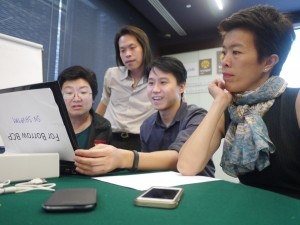
Team Phoenix starts to tackle the simulation
It’s during these early stages that we saw the team dynamic beginning to emerge. Who is the de facto leader of each team? How do they negotiate a strategy as a team? How do they handle a team member whose suggestions might just not be working out very well? Who is the fastest at the keyboard? If the person at the keyboard is not very adept, who will step up and take over from them?
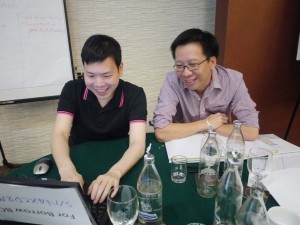
Team Bushido busy cracking the secret behind the simulation!
After Round 1, Team Bushido emerged victorious. What was the secret to their success?
Strategy.
They had quickly figured out that they had a limited number of trial runs, so needed to be strategic about what to test. They made educated guesses, about which levers had the greatest impacts in the portfolios and focused on testing those.
As coaches, we paid close attention to the team in last place, “007”. How did they manage such a huge loss in an easy round? We’ve done this enough times to know not to panic. The team was smart and working cohesively as a team. So what was the problem?
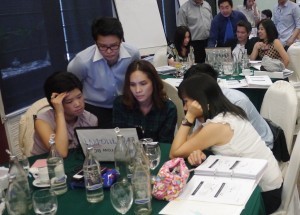
Team 007 – Trying to make sense of the data is tougher than it looks!
Focus.
The simulation can be a bit overwhelming. Teams are blasted with data – customer segment behavior, market data, and P&L statements for four portfolios. It’s crucial that teams review the reports carefully and systematically before deciding on their strategy.
Team 007 listened to their coaches’ advice, tightened up their focus, and didn’t give up. With just a few extra hints and encouragement, by Round 3, they had moved from sixth place to third place! Since the other teams were honing their strategies at the same time, this was no small feat.
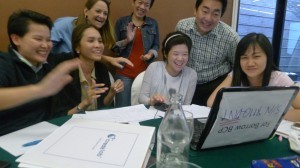
Team 007 – Their perseverance pays off and they finally start seeing some great results!
In Round 2 and 3 the difference in results between the teams got tighter and tighter. Team Bushido continued to dominate the top of the leaderboard with Team Phoenix on their heels in second place. How did they do it?
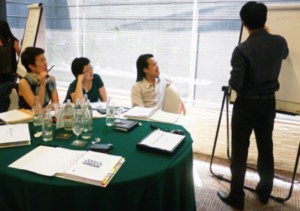
Team Phoenix deliberating which strategies they should test next!
Consistency.
We noticed that Team Bushido and Team Phoenix discussed their strategy carefully at the beginning of each round, and kept their testing in the trial runs very focused.
Materiality.
There is a lot of data to analyze in the simulation. The winning teams figured out that they needed to identify the decisions had the biggest material impact on the P&L and focus there. As they say, “Don’t sweat the small stuff”.
Timing.
Team Phoenix managed their time well and was the only team that completed round 3 within the specified timeframe – while each of the other 5 teams suffered overtime penalty.
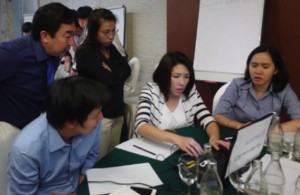
In a downturn stress levels rise – always remember to keep cool in a crisis!
In a downturn stress levels rise – always remember to keep cool in a crisis!
Keep cool
– especially in a crisis. In the final round, all of the teams are hit with an economic downturn. They stress tested their portfolios in the trial runs. Since there are overtime penalties, sometimes teams panic and start to make irrational decisions. Sometimes they just get overwhelmed from looking at too much data and have a bit of a meltdown.
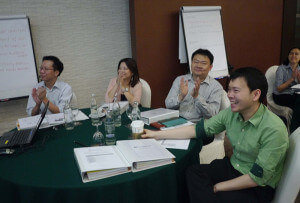
Team Bushido kept their cool through to the end to dominate!
Congratulations Team Bushido – your combination of focus, consistency and great teamwork won the game!
On Slideshare –
CreditLab: Reality Show or Training? from Michelle Katics


